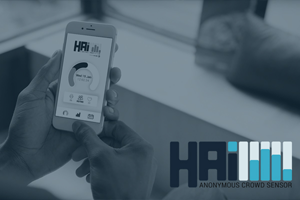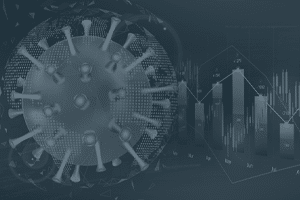The COVID-19 pandemic is a crisis unlike any other in recent times. Governments and organizations continue to work hard to contain and fight this pandemic, but the growing humanitarian toll is severe. Consumers need to stay home as much as possible, and businesses are temporarily closing or reducing production. Companies experience a decrease in revenue and income, and unemployment rates rise. With this blog we want to help companies from different sectors that are struggling. We want to provide insights on how to deal with current challenges, and how things are changing and will change in the future.
This storm will pass. But the choices we make now
Y. Harari
could change our lives for years to come.
Content
A unique window of opportunity to focus on adjacent innovations
29/05/2020
Painfully gradual, the lockdown measures are being lifted and in small steps consumption and businesses are starting up again in Europe. It is becoming increasingly clear that this pandemic crisis and the resulting measures have caused significant economic damages. Based on predictions, we can estimate that the crisis will last between 18 and 24 months.
At Verhaert, we know from best practices in innovation management that this creates the opportunity for new players to enter market spaces, by developing products from scratch focused on system level innovation. This creates a unique window of opportunity to focus on adjacent innovations, first generation innovations supporting your growth strategy. Due to the significant shift in user demand, we can assume that the relevance of incremental innovations will reduce. This offers space to shift the focus on accelerating digitization and servitization of the product range.

CEO Verhaert
Using AI and big data will help understand changing customer behavior faster and better
25/05/2020
The Covid-19 pandemic is the first pandemic to shift people’s work and hobbies to at home options on a massive scale. This was largely possible due to access to online digital technologies. Because of to this behavioral change, businesses all over the world are facing challenges in terms of gathering accurate insights. They find it difficult to anticipate what’s next in order to stay viable and accommodate the rapid changing environment with adapted products and services. Qualitative field research approaches are long and expensive, and result in companies releasing new products late in the market. McKinsey’s report on digital technology adoption showed that only 13% of retail companies were using AI as part of their product development.
Businesses need to accommodate new market research methods to understand the new normal trend much faster. Companies are forced to learn in real time how they can adapt to these changes by exploring the use of virtual showrooms, driverless delivery fleets and driverless steps. Connected research methods will generate data everywhere in the world, which will create new, and even more qualitative and updated data. Using AI and big data will help understand the new behavior faster and better.

Director Business Development
The worst is behind us, how do we move forward?
14/05/2020
Finally, after a couple of months, we can see that the curve is eventually flattening. Governments are lifting the lockdown and companies are rushing to recover from the economic bump. It’s too early to predict the future of the economy and the full impact of Covid-19. Nevertheless, a recession seems inevitable. Despite the harmful effects of this situation, there are still silver linings in this story that can leverage our recovery and evolution as a society.
In times of crisis, the wise build bridges while the foolish build barriers.
Social distancing and lockdowns forced every company to look into the alternatives of on-site working. Every day millions of people are connecting to their Microsoft Team, Zoom, Google Meet, Webex, meetings keeping the wheels of the economy turning. Organizations have invested in their telecommunications infrastructure to ensure the continuity of their business and strengthen their online presence. Communications today are done digitally, and everyone is embracing and enjoying the change.
The Chinese use two brush strokes to write the word ‘crisis.’ One brush stroke stands for danger and the other for opportunity. In a crisis, be aware of the risk — but recognize the opportunity.
In response to this pandemic, innovators are jumping to help. Beer makers are producing hand sanitizers, and 3D printing companies are saving lives by creating valves used in hospitals and ventilators. Artificial Intelligence is allowing the development of tools for spread modeling, symptoms, and people tracking. Farmers are increasingly using e-commerce to sell their goods directly to customers. Markets that seemed dommed are embracing digital technologies as a way to enhance their brand awareness and business.
When we look back on this crisis, we’ll see that innovation and support never stopped and that the companies that thrived diversified their business model and culture to adapt to the situation.

Business Development Manager
Services – Digital innovation
Will Covid-19 make supplies less dependent of global sourcing and lead to a decrease in globalization?
11/05/2020
One implication of the Covid-19 crisis was the rapidly closing borders worldwide, which inevitably resulted in delivery problems. Companies are became vulnerable because they could not and still cannot get the parts they need to continue production. Global just-in-time supply chains came to a hard stop and will remain under pressure until Covid-19 is defeated worldwide. This begs the question: “Should companies change their supply chain?”. Continuity of supply has become just as valuable, and sometimes even more valuable than production cost and speed to market. Supply chains built on just-in-time inventory and distributed component sourcing have to be reconsidered. Companies will need to start redesigning their supply chain, re-engineering old products so they do not rely on one specific supplier, and modifying product designs to accommodate for a resilient supply chain of several potential, mainly local, suppliers.

Business Development Manager
Solutions – Smart industry & chemicals
How will this global crisis influence new product and service development?
04/05/2020
Only a number of weeks into the Covid-19 era, and we can already see companies seizing new opportunities. With remarkable speed, start-ups and other companies are introducing electronics to safeguard social distancing for their workers and apps to trace contacts and so on (more info).
However, many more have started to investigate how this global crisis will affect our habits and behavior, influencing their new products and services. Safety and wellbeing were already trends and behavioral drivers in smart buildings and cities. The post-pandemic world will add new constraints and features to product and services design.
- Will purified air become a differentiator in public transport, retail shops, restaurants and office buildings? There already is an increased demand for such devices in hospitals and ‘critical’ spaces like control rooms. As there already was a growing awareness for (indoor) air quality, accelerated and widened adoption is certainly possible.
- Will handles, doorknobs and other touched surfaces all have to become antimicrobial to stand a chance in the market? Will user interfaces become touchless?
- Will the soap dispenser on the sink order its own refills via IoT, as the online shopping adoption boost will enable the breakthrough of FMCG subscription models?
These possibilities are not new, but can rapidly accelerate due to today’s crisis. At Verhaert, we recently developed an IoT device to enable a dishwashing subscription model. We monitored air quality and VOC propagation in a production environment and are working on wearables that monitor and detect health issues and behavior. We expect more of this to come. Our designers, developers and engineers can support you in envisioning and developing your future smart products.

Business Development Manager
Solutions – Smart city, home & mobility
How can we avoid ‘big brother’ when using technology to get out of the lockdown?
30/04/2020
How will technologies interfere with our lives in the future. China has showed the world that strict lockdown can only be enforced and made successful with controlling technologies. On top of that, China demonstrated that lifting the restrictions and avoiding a new outbreak is much easier and more controllable when using technologies such as fever measuring cameras at entrances or drones, smartphones, watches and dedicated small devices that use RF technology to measure distances.
These devices can come in handy to help us cope with the new normal, such as alert when desired ranges are exceeded. They seem to be acceptable tools, but what with personal data? And what about solutions that measure fever before badging in? Or drones measuring fever and interpersonal distance, or even identify you through facial scanning and recognition? Some of our basic rights might be in danger. The freedom upon which our European communities, cultures and laws are build, is being challenged.
Software and data integrity, privacy and security technologies are needed to ensure these rights. These technologies are not commonly available and cannot yet proof a trustworthy application. Here trustworthy AI rules can play an important role, however EU guidelines will not be enough to ensure qualified implementations, so we might need certification processes. The currently used AI approaches for distributed learning raises some critical issues in this kind of application. Verhaert’s AI lab is investigating how trustworthy AI and federated learning can solve these issues for particular cases.

Director Business Development
The impact of the Corona crisis on medical products & services
24/04/2020
The corona crisis forces us to rethink the way we look and use medical products and services. Telemedicine, robotic devices, camera technology and new patient monitoring devices are needed, responding to the changing methods of patient investigation and monitoring. Brands need to be flexible, and existing protocols and habits need to be changed. This will require that your customers adapt to your proposed new behavior, which is often unknown behavior.
Knowing that 68% of the medical inventions do not take off due to customer rejection, special attention needs to be paid on how to avoid these rejections.
We see that the root cause of many of these market failures is found in insufficient behavioral research. The analysis of how a user behaves towards a product is essential. Contextual inquiries and observations will help you to understand all external factors that might influence human interfaces. During these insightful activities you have to search for hidden needs. Needs of which the users themselves didn’t know they had them. This is how we believe a product becomes meaningful.
A true fit-to-market medical device eliminates unintended use, use-related hazards and rejection
Our perspective ‘Behavioral design beyond Human Factor Engineering’ discusses such customer behavior research in detail.

Business Development Manager
Solutions – Smart Medical & Health
The struggle between reducing R&D budgets and long-term growth
21/04/2020
During Corona-times, optimists would say that ‘every crisis is a birth’, and for some aspects this is truly the case. Organizations discover that employees can actually work from home and so colleagues adopt a new sense of work-life balance.
On the other hand, various companies experience a defensive reflex to keep the spiraling losses under control, especially in high-impact industries like construction, tourism and entertainment. In these challenging times, executives are looking for cost-cutting options on the short and mid-term.
It’s totally understandable that in times where demand is plummeting, organizations refocus all their efforts on the essential business processes. However, the current operations and business processes could not be executed if it weren’t for past investments in R&D. Let’s consider 5 ways for your innovation and R&D team to deal with the Corona crisis.
Our perspective ‘5 ways for your IR&D team to deal with the Corona crisis’ discusses this topic more in dept.

Coordinator InnoLab
Re-evaluated innovation trends in agri- and horticulture due to Covid-19 outbreak
15/04/2020
The Corona-virus has been quite impactful on the Agricultural industry to say the least. Estimations on damages exceed €135 million in horticulture and €200 million for potato farmers, and let’s not even mention the sugar market.
The losses can largely be derived from the forced lockdowns, but will leave persisting influences (good and bad) within the different segments. With global lockdowns, the ‘out-of-door’ market (restaurants, canteens, events) has been closed or cancelled causing worries, but also inciting creativity on what to do next and which measures to take to support the value chain. Due to the current travel restrictions, farmers will have think twice on either automating part of the harvest or waiting for travel restrictions to be lifted for seasonal workers. Either way products might get spoiled, causing supply chain problems later on.
These challenges can be drivers for innovation if the quarantine persists. Some examples:
- Shifting business models and procedures: The so-called ‘buurderijen’, or online local farmers markets, are working non-stop because buying local is hot.
- Autonomous harvesting robots for strawberries, oranges, peppers, asparaguses and cucumbers already exist and can be sourced quickly to alleviate labor shortages. Opportunities in tomato harvesting should be considered too.
- Remote monitoring of crops through hyperspectral sensors and additional cameras (fixed, aerial or satellite) will significantly reduce the inspection time and number of interactions between inspector and plant information on irrigation, nutrition, …
- Augmentation of current systems a lot of data is gathered already, but can be further leveraged to optimize working hours, inspection (of quality, fytotoxicity, fungi, bacteria) through machine learning and potentially big data techniques.
With the situation evolving from day to day, multiple parallel routes should be taken and investing in innovation and new technologies will remain valuable.

Business Development Manager
Services – Technology Transfer
Remote & predictive maintenance for offshore industry challenges
09/04/2020
When times are hard, change is easy right? Yet Covid-19 is testing us all, by causing so much to change in days. People have to think twice about the change in the future inspired by doing more with less. Many industries had to start thinking differently, too, to make sure they stay afloat.
The offshore industry is one of those industries that had to find solutions in a short amount of time to maintain our present and future energy supplies, while finding a work-life balance and providing healthy working conditions. Hats off for those on-site working double shifts now due to travel restrictions and an obligation to stay. Usual shifts of 3 weeks have been extended by long double shifts of 6 weeks, which also means more time away from their relatives.
Sometimes they have to keep everything going with less crew members, creating innovative ideas to find new future solutions. Machine monitoring and digitization are just a few examples of how to achieve remote assistance. Machine maintenance is becoming more predictable, allowing more reliable remote surveillance and controlling. Remote and predictive maintenance might offer solutions to further reduce the number of remote visits and avoid social distancing problems. Therefore they are speeding up the shift to digitization, where AI and tools like SVM are ideal to train predictive analysis on normal versus abnormal machine behavior.

Business Development Manager
Services – Product Innovation
Take away and grocery delivery tools soar during Covid-19 lockdown
06/04/2020
The current lock down implies large-scale quarantines, travel restrictions, and social distancing. People are discouraged to travel beyond their neighborhood and limited to shopping in the local supermarkets and pharmacies. As outdoor activities, restaurants, theaters and cinemas are closed, people start ordering online. An increase in online grocery shopping, fridges, bread maker, clippers have been identified.
A google search report showed the following results: Pre-outbreak mobile searches for “grocery delivery” grew over 130% in the past two years. And according to NPD, the number of U.S. consumers who shopped online for groceries, increased by about 51 million between November 2018 and February 2019. “Take away” search interest has increased 285% since the beginning of March. Being there to help people navigate this new normal with up-to-date and relevant information, can make all the difference.
In the short term, innovators will need to find ways to help deliver adapted solutions to meet this new demand.
Find out more on this topic in the perspective ‘The impact of the Covid-19 lockdown and its aftermath‘.

Director Business Development
Corona pushes all of us to use digital tools
03/04/2020
At Verhaert we believe innovation should be user centered, technology enabled and business focused. In that sense companies that expect to go back to business as usual after Covid-19, make a tremendous mistake and will be blown away by competition. The reason for that is simple. Your customers and end-users are no longer the same. In just a couple of weeks’ time, we all changed our behaviors and habits, a huge switch that would take years under normal circumstances.
What would have been the percentage and demography of our population that used web conference tools before Corona? Now, Covid-19 pushes all of us to use these tools, from youngsters to elder people. In just a few weeks, customers barriers and reservations to use such tools have dropped tremendously. Imagine the potential for all your sales processes around consultative solutions.
How many people had their first online purchase experience over the last weeks? How many people have been forced to leave the time of using physical money finally behind them? How many fanatic book readers have taken the step towards digital books over the last days? Which digital tools you have started using recently in your attempt to manage your business remotely?
People that have started to use those digital tools and services over the last weeks, will continue to use them in future. Covid-19 forced us to change our behavior and adopt new solutions. Once people change their behavior they don’t go back. We should make sure we adapt our products and services towards this new reality, and even take advantage of it to optimize our business model.

CEO Verhaert
Corona causes not only a humanitarian crisis, but also important societal challenges
02/04/2020
In a thought provoking Financial Time article ‘The world after coronavirus’, Yuval Noah Harari warns that today’s choices will have an impact on the post-Corona world. Will we choose for global cooperation or more protectionism?
Harari states it bluntly: “This storm will pass. But the choices we make now could change our lives for years to come. One method is for the government to monitor people with facial recognition and drones, and punish those who break the rules.” Are we aware that the powerful technologies tracking the spread of SARS-COV-2, can enable far reaching surveillance that could be kept in place permanently by totalitarian regimes and malevolent entities? Harari shows the danger in corporations and governments that start harvesting our biometric data. They could get to know us far better and predict our feelings, but also manipulate them and sell us anything.
Nevertheless, the industry will need to adapt to the world after Covid-19. They will need to build and offer solutions considering the new behavior and context, and how it will affect customer’s habits and behavior, and hence design new improved products. Some examples:
- Will smart homes and wearables powered by AI become our health guardians? Will they continuously monitor our health, or will we choose ethical AI systems respecting our privacy?
- Will the increased focus on washing hands stick and change how we use and buy soap and similar products? Will my smart watch notify me that I haven’t washed my hands? Will companies monitor customers through facial recognition software in the surveillance systems?
- Will vending machines, coffee dispensers and other user interfaces become touchless? Current explorations in voice and gesture control might have to be implemented now. Facial recognition, as already implemented in China, could make its big breakthrough in Europe, facilitating electronic payments and customer loyalty programs and further preventing cash transactions and pin code entries.

Business Development Manager
Solutions – Smart city, home & mobility




